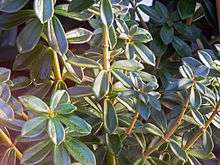Peperomia
Peperomia (radiator plant) is one of the 2 large genera of the Piperaceae family, with more than 1000 recorded species. Most of them are compact, small perennial epiphytes growing on rotten wood. More than 1500 species have been recorded, occurring in all tropical and subtropical regions of the world, though concentrated in Central America and northern South America. A limited number of species (around 17) are found in Africa.
Description
Though varying considerably in appearance (see gallery below), these species generally have thick, stout stems and fleshy leaves, sometimes with epidermal windows. Peperomia flowers typically come in yellow to brown conical spikes.
These tropical perennials are grown for their ornamental foliage.They are mostly natives of tropical America. They are compact and usually do not exceed 12 inches (30 cm) in height. They vary considerably in appearance. Some have threadlike, trailing stems and some have fleshy, stout stems. The leaves are smooth and fleshy and may be oval with the leafstalk at or near the center of the leaf blade, or they may be heart-shaped or lance-shaped; their size may vary from 1–4 inches (2.5–10.2 cm) long. They may be green or striped, marbled or bordered with pale green, red or gray, and the petioles of some kinds are red. The tiny flowers are unnoticeable and they grow in the form of cordlike spikes
Horticulture
Peperomias are grown for their ornamental foliage and sometimes for their attractive flowers (Peperomia fraseri). Except for the succulent species, they are generally easy to grow in a greenhouse. Different species (e.g. Peperomia caperata) and cultivars are found in the trade.
Propagation
These plants are usually propagated by seeds. They are also commercially propagated by cuttings. Peperomia cuttings root easily.
Plants can be divided at potting time. They are removed and separated into smaller pieces, each with a few roots attached. Leaf or stem cuttings can also be taken in the spring or summer. The lower leaves of the shoots are removed and a cut is made below the bottom node (joint). They are then laid on a bench for an hour or two to allow a protective callus tissue to form over the cuts. They are then inserted in a propagating case with bottom heat of 70-75 degrees F. It is best not to seal the top completely, as the plants are semi-succulent in nature and excessive humidity is detrimental. When enough roots have formed, cuttings can be planted in 3-inch pots or in hanging baskets.
Gallery
 Peperomia argyreia, watermelon peperomia
Peperomia argyreia, watermelon peperomia Peperomia blanda
Peperomia blanda Peperomia camptotricha
Peperomia camptotricha Peperomia caperata
Peperomia caperata Peperomia caulibarbis
Peperomia caulibarbis Peperomia claviformis
Peperomia claviformis Peperomia clusiifolia "Jely"
Peperomia clusiifolia "Jely" Peperomia columella
Peperomia columella Peperomia cookiana
Peperomia cookiana Peperomia flexicaulis
Peperomia flexicaulis Peperomia glabella
Peperomia glabella
 Peperomia griseoargentea
Peperomia griseoargentea Peperomia hirta
Peperomia hirta Peperomia hoffmannii
Peperomia hoffmannii Peperomia hylophila
Peperomia hylophila Peperomia incana, a large herb
Peperomia incana, a large herb Peperomia leptostachya
Peperomia leptostachya Peperomia macrostachya
Peperomia macrostachya Peperomia magnoliifolia
Peperomia magnoliifolia Peperomia meridana
Peperomia meridana Peperomia myrtifolia
Peperomia myrtifolia Peperomia nitida "Variegata"
Peperomia nitida "Variegata" Peperomia nivalis ssp./var. crassa, a xerophyte
Peperomia nivalis ssp./var. crassa, a xerophyte
 Peperomia orba "Variegata"
Peperomia orba "Variegata".jpg)
 Peperomia perciliata
Peperomia perciliata Peperomia pereskiifolia
Peperomia pereskiifolia Peperomia prostrata, a hanging or creeping succulent
Peperomia prostrata, a hanging or creeping succulent Peperomia puteolata
Peperomia puteolata Peperomia quadrangularis
Peperomia quadrangularis Peperomia rotundifolia var. rotundifolia
Peperomia rotundifolia var. rotundifolia Peperomia rubella
Peperomia rubella Peperomia sandersii
Peperomia sandersii Peperomia serpens
Peperomia serpens- Peperomia sincorana
- Peperomia tetragona


 Peperomia trifolia
Peperomia trifolia Peperomia tuisana
Peperomia tuisana Peperomia vinasiana
Peperomia vinasiana Peperomia weberbaueri
Peperomia weberbaueri
See also
External links
| Wikimedia Commons has media related to Peperomia. |
